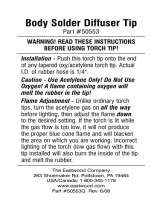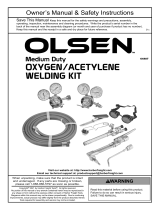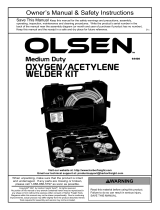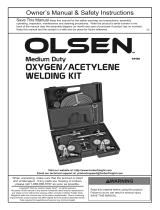Page is loading ...

INSTRUCTIONS for
F-4644-N
June 2009
W-17 Welding Torch
P/N 4250
These INSTRUCTIONS are for experienced operators. If you are not fully familiar with the principles of operation
and safe practices for oxy-fuel gas equipment, we urge you to read our booklet “Precautions and Safe Practices for
Gas Welding, Cutting and Heating” Form 2035. Do NOT permit untrained persons to install, operate, or maintain
this equipment. Do NOT attempt to install or operate this equipment until you have read and fully understand these
instructions. If you do not fully understand these instructions, contact your supplier for further information.
The welding torch covered by these instructions is listed by Third Party Listed only when used in combination with
welding tips and parts manufactured by ESAB Welding & Cutting Products to the specications on le with Third
Party Listed, and when they are used in the gas services for which they are designed and listed. The use of other
parts that cause damage or failure to the equipment will void the manufacturer’s warranty.
SPECIFICATIONS
Welding Range ..........................This gauge to over 1-in.
Heating Range ............................1 to 250 cfh acetylene*
Length ................................................................ 7-1/2-in.
Weight .......................................................................1 lb.
Torch-Hose Connections .................Oxy - 9/16 - 18 fem.
F.G. - 9/16 - 18 LH fem.
* Equivalent to approximately 1400 to 370,000 Btu/hr.
Acetylene and other fuel gases may be used.
OPERATING INSTRUCTIONS
CONNECTING
1. Attach regulators to the oxygen and acetylene
cylinders. Follow all instructions supplied with your
regulators.
2. Attach oxygen and acetylene hoses to the regu-
lators and to the torch handle, after making sure
all metal seating surfaces are clean. Tighten all
connection nuts with a wrench.
3. Attach welding or heating head to the torch handle.
Tighten the connection nut with a wrench, but use
only slight force, since the threads have a low pitch
and excessive force may distort them.
4. Check throttle valve packing nuts for tightness.
Flashbacks can cause serious burns.
Be sure gas ow is sufcient for head or nozzle size.
Adjust regulators for proper psig pressures. Adjust
throttle valves properly. Keep torch in good repair. DO
NOT throttle back gases to use large head or nozzle
on thin material.
LIGHTING AND FLAME ADJUSTMENT
1. Open the torch oxygen valve one-quarter of a
turn.
2. Open the torch fuel gas valve one-half turn (two
full turns if low-pressure acetylene is being used)
and light the gas at the tip with a friction lighter. DO
NOT USE A MATCH. Use of a match can seriously
burn your hand.
3. Open the oxygen valve wide and adjust the fuel
gas valve to secure the desired ame. If a softer
ame is desired, reduce the oxygen ow by throt-
tling the oxygen valve and then readjust the fuel
gas valve.
NOTE: When operating with a very soft ame, the
welding head will tend to heat up and transfer
some of this heat to the torch handle. This may
create some discomfort to the operator.
SHUTTING OFF
Close the fuel gas valve rst, then the oxygen valve.
If operations are to be stopped for a half-hour or more,
all pressure should be released from the torch hoses,
and regulators by doing the following:
1. Close each cylinder or station valve.
2. Open torch valves.
3. After relieving the gases, back out the pressure-
adjusting screw of each regulator and close the
torch valves.
Be sure this information reaches the operator.
You can get extra copies through your supplier.

2
BE SURE THIS INFORMATION REACHES THE OPERATOR.
YOU CAN GET EXTRA COPIES THROUGH YOUR SUPPLIER.
SAVE THESE INSTRUCTIONS!
IMPORTANT SAFEGUARDS
When using Oxy-Fuel Gas Torches, basic safety precautions should always be followed:
Never use Acetylene gas at a pressure over 15 psig.a.
Never use damaged equipment.b.
Never use oil or grease on or around Oxygen equipment.c.
Never use Oxygen or fuel gas to blow dirt or dust o clothing or equipment.d.
Never light a torch with matches or a lighter. Always use a striker.e.
Always wear the proper welding goggles, gloves and clothing when operating Oxy-Acetylene equipment. f.
Pants should not have cus.
Do not carry lighters, matches or other ammable objects in pockets when welding or cutting.g.
Always be aware of others around you when using a torch.h.
Be careful not to let welding hoses come into contact with torch ame or sparks from cutting.i.
SAVE THESE INSTRUCTIONS.j.
This equipment will perform in conformity with the description thereof contained in this manual and accompa-
nying labels and/or inserts when installed, operated, maintained and repaired in accordance with the instruc-
tions provided. This equipment must be checked periodically. Malfunctioning or poorly maintained equipment
should not be used. Parts that are broken, missing, worn, distorted or contaminated should be replaced imme-
diately. Should such repair or replacement become necessary, the manufacturer recommends that a telephone
or written request for service advice be made to the Authorized Distributor from whom it was purchased.
This equipment or any of its parts should not be altered without the prior written approval of the manufacturer.
The user of this equipment shall have the sole responsibility for any malfunction which results from improper
use, faulty maintenance, damage, improper repair or alteration by anyone other than the manufacturer or a ser-
vice facility designated by the manufacturer.
These INSTRUCTIONS are for experienced operators. If you are not fully familiar with the prin-
ciples of operation and safe practices for gas welding and cutting equipment, we urge you to read
our booklet, “Precautions and Safe Practices for Gas Welding, Cutting, and Heating,” Form F- 2 0 3 5 .
Do NOT permit untrained persons to install, operate, or maintain this equipment. Do NOT attempt
to install or operate this equipment until you have read and fully understand these instructions. If
you do not fully understand these instructions, contact your supplier for further information. Be
sure to read the Safety Precautions before installing or operating this equipment.
CAUTION
USER RESPONSIBILITY
READ AND UNDERSTAND INSTRUCTION MANUAL BEFORE INSTALLING
OR OPERATING. PROTECT YOURSELF AND OTHERS!

3
�
4. WARNING: This product, when used for welding or
cutting, produces fumes or gases which
contain chemicals known to the State of
California to cause birth defects and, in
some cases, cancer. (California Health &
Safety Code �25249.5 et seq.)
Means immediate hazards which, if not avoided,
will result in immediate, serious personal in-
jury or loss of life.
Means potential hazards which could result in
personal injury or loss of life.
Means hazards which could result in minor
personal injury.
MEANING OF SYMBOLS - As used throughout
this manual: Means Attention! Be Alert! Your
safety is involved.
SAFETY PRECAUTIONS

4
IMPORTANT OPERATING NOTES
1. Do not attempt to operate heads size 100 or larger
from a low-pressure acetylene supply (less than 5
psig).
2. Head size number of each welding and heating head
indicates the rated acetylene capacity in cubic feet/
hour (cfh). For example, No. 55A requires about
55 cfh of acetylene at normal operating pressure.
However, on heating heads designed for other fuel
gases, the size indicates the approximate equiva-
lent heating capacity in terms of acetylene ow.
For example, No. 100A and No. 100FG provide
the same average heating output (147,000 Btu/hr)
but No. 100FG head really requires about 62 cfh
of FG-2, 57 cfh of propane, or 147 cfh of natural
gas.
For consumption purposes, the following are the
oxygen/fuel gas ratios normally required for welding
and heating:
1.1 to 1.5 cfh oxygen/1.0 cfh acetylene
3.2 to 3.6 cfh oxygen/1.0 cfh FG-2
3.5 to 4.5 cfh oxygen/1.0 cfh propane
1.7 to 2.0 cfh oxygen/1.0 cfh natural gas.
PRECAUTIONS - NO. 55 and LARGER HEADS
Large welding and heating heads (No. 55 and above)
require high ow of oxygen and fuel gas for proper op-
eration. Failure to follow the following precautions
can result in serious overheating, ashback, and
possible operator injury.
1. Read and understand the operating instructions
packed with your torch as well as these precautions
before lighting up the welding or heating head.
2. Always operate with oxygen and fuel gas pressures
given in the tables.
3. Do NOT use hose line reverse ow check valves
when using No. 100 or larger welding or heating
head.
4. Use 3/8-in. I.D. hoses when using No. 55 or larger
welding or heating head.
5. Do NOT use whip hose, hose splices, nor hose
nipples smaller than 1/4-in. I.D. (“B”-size).
6. If using hose lengths greater than 25-ft., or if there is
any doubt about the adequacy of gas ows, use an
oxygen test gauge adaptor (P/N 07X17) and either
the acetylene (P/N 262510) or fuel gas (P/N 639422)
test gauge adaptor while the torch is operating to
make sure that the recommended operating pres-
sures are available at the torch inlet.
7. Manifold two or more fuel gas cylinders to assure
adequate supply of fuel gas. The tables show the
number of commonly used cylinders recommended
for manifolding when using larger heads. If using
other cylinders or gases, check with your fuel gas
supplier for recommended withdrawal rate informa-
tion.
8. In the event of a ashback, immediately close both
oxygen and fuel gas valves on the torch (preferably
oxygen valve rst). For greater protection, install
1/4-turn quick shut off valve (P/N 999306) on the
torch oxygen hose connection.
Acetylene
Head Flowrate, Min. No. of Cylinders Required*
Size cfh WK Cyl (300 cf) WTL Cyl. (390 cf)
55 55 2 1
70 70 2 2
100 100 3 2
150 150 4 3
200 200 5 4
250 250 6 5
* Based on that max. hourly owrate should not exceed 1/7 of cylinder
capacity at 70° F. Example: 1/7 (300 cf WK cyl.) = 43 cfh max.
FG-2 (104 Ib. cyl.) Propane (100 Ib. cyl.)
Head Min. No. of Min. No. of
Size Flowrate Cyl Req’d* Flowrate Cyl. Req’d**
70 43 1 40 1
100 62 1 58 1
150 93 1 86 2
200 124 2 116 2
250 - - 144 3
* Based on max. continuous withdrawal rate of 110 cfh for 104 Ib. cylinder,
1/2 full @ 70° F.
** Based on max. continuous withdrawal rate of 65 cfh for 100 lb. cylinder,
1/2 full @ 70° F.
Withdrawal rate will increase with wind velocity and intermittent usage;
reduce with lower temperature.
9. If the inner cone of the ame appears too short
(less than 1/4-in.), you are lacking fuel gas and
the head will tend to overheat. Recheck the above
precaution with your set up.
10. Do not bring the head too close to the work. Main-
tain a distance of at least 1/4-in. between tip and
work.
RECOMMENDED HOSE SIZES
Oxygen, Acetylene (medium-pressure) and Natural
Gas (at pipeline pressure over 5 psig): With head
sizes 4-30, 1/4-in. or 3/8-in. I.D. With head sizes 55
and larger, 3/8-in I.D.
Acetylene (low-pressure) and Natural Gas (at pipe-
line pressure below 5 psi): With head sizes 4-70,
3/8-in. I.D. hose. Head sizes 100-250, 1/2-in. hose.
Do not use over 25 feet of hose.

5
Heating Head Operating Replacement Parts Tip Injector Tip Extensions
Assembly Pressure Cleaning Cleaning (Accessory)
Fuel Tip Tip Mixer No. of Drill Drill
Size Part No. Oxygen Gas Ass’y Stem Nut Tube Injector Holes Size Size Length Part No.
For Acetylene Use
55 O-A 998819 35-40 1/2-5 998797 998792 639969 639971 01Z14 9 61 59 12-in. 19X42
70 O-A 998820 45-50 1/2-5 998798 998792 639969 639972 01Z15 9 57 57 12-in. 19X42
100 O-A 998821 55-60 1/2-5 998799 998793 33A59 16Z54 01Z21 13 57 56 15-in. 19X43
200 O-A 998822 15-20 9-12
998800 998794 998830 998832 16 54 47 18-in. 998790
250 O-A 998823 20-25 12-14
998827 998826 998831 998832 16 53 47 21-in. 998825
For Fuel Gases Other Than Acetylene (FG-2, propane, natural gas, etc.)
70 O-FG 999232 40-45 1/2-5 999224 998792 639969 639972 01Z23 8 51 54 12-in. 19X42
100 O-FG 999233 50-70 1/2-5 999227 998793 33A59 16Z54 01Z99 8 52 56 15-in. 19X43
200 O-FG 999234 30-55 6-11
999230 998794 998830 998832 21 52 47 18-in. 998790
Welding and Heating Head Parts
Table 1 - Single-Flame Acetylene Welding Heads
Welding Replacement Parts Cleaning Drill Tip
Head Oxygen (Size No.) Extension
Assembly Metal Thickness Pressure Tip Mixer for for (Accessory)
Size
Part No. In. mm. psi Tip Nut Tube Injector Tip Injector Length Part No.
4A 639865 1/32-1/16 0.8-1.6 7-18 639684 16Z26 01Z06 64 79
6A 639866 1/16-3/32 1.6-2.4 8-20 639685 16Z27 01Z07 58 77
9A 639867 3/32-1/8 2.4-3.2 10-24 639686 639870 16Z28 01Z08 55 75
12A 17270 1/8-3/16 3.2-4.8 10-25 17266 16Z29 01Z09 53 73
15A 639868 3/16-1/4 4.8-6 11-26 639687 16Z30 01Z10 53 71
30A 639869 1/4-1/2 6-13 18-29 17261 998847 16Z32 01Z12 45 65
55A 998101 1/2-3/4 13-19 25-39 998060 639969 639971 01Z14 33 59 12-in. 19X42
70A 998102 3/4-1 19-25 22-30 998061 639969 639972 01Z15 30 57
100A 10X03 45-55 998062 33A59 16Z54 01Z21 25 56 15-in. 19X43
150A 10X05 Heating 50-60 64Z22 33A58 16Z56 01Z23 17 54 18-in. 19X44
250A 10X07 70-80 12Z80 33A63 16Z58 01Z25 1/4-in. 52 21-in. 19X45
Table 2 - Standard Multiame Heads
Heating Head Replacement Parts Tip Cleaning Injector Tip Extensions
Assembly Oxygen Cleaning (Accessory)
Pressure Tip Mixer No. of Drill Drilll
Size
Part No. psi Tip Nut Tube Injector Holes Size Size Length Part No.
For Acetylene Use
70A 998047 40-45 998071 639969 639972 01Z15 7 56 57 12-in. 19X42
100A 11X22 55-60 998072 33A59 16Z54 01Z21 8 55 56 15-in. 19X43
150A 11X24 60-65 998073 33A58 16Z56 01Z23 12 55 54 18-in. 19X44
250A 11X26 75-80 12Y44 33A63 16Z58 01Z25 12 55 52 21-in. 19X45
For FG-2 Use
70 FG 998038 33-70 998078 639969 639972 01Z25 7 54 52 12-in. 19X42
100 FG-2 998281 34-88 998079 33A59 16Z54 01Z25 8 48 52 15-in. 19X43
150 FG-2 998265 32-70 998036 33A58 16Z56 998286 12 48 46 18-in. 19X44
For Fuel Gases Other Than Acetylene & FG-2
70 FG 998038 33-70 998078 639969 639972 01Z25 7 54 52 12-in. 19X42
100 FG 11X32 45-55 998079 33A59 16Z54 01Z21 8 48 56 15-in. 19X43
150 FG 11X34 50-60 998036 33A58 16Z56 01Z23 12 48 54 18-in. 19X44
250 FG 11X36 70-80 12Y60 33A63 16Z58 01Z99 20 48 50 21-in. 19X45
Table 3 -Rosebud-Style Multiame Heating Heads
Size indicates approximate acetylene ow rate in cu. ft./hr (cfh) at normal operating pressure. See Important Operating Notes on pg. 3.
Acetylene pressure is 1/2 to 5 psi.
See Important Operating Notes on pg. 3.
Fuel Gas pressure is 1/2 to 5 psi.
See Important Operating Notes on pg. 3. This stainless steel extension requires coupling 998838 for 200 size; 998839 for 250 size.
IMPORTANT: P/N 998832 is a mixer; not an injector for low fuel gas pressure. Be sure to use operating pressures as given.
†
†
†
†

6
TESTING FOR LEAKS
Every welding and cutting outt should be thoroughly
tested for leaks after it is rst hooked up, and at regular
intervals thereafter. After all connections have been
made, make sure both valves on the torch handle are
closed. Then turn in the regulator pressure-adjusting
screw until the oxygen delivery-pressure gauge reg-
isters 50 psi, the acetylene delivery-pressure gauge
registers 10 psi. Using Leak Test Solution suitable for
oxygen service, such as P/N 998771 (8 oz. container),
check for leaks at the cylinder valves, the cylinder-to-
regulator connections, the regulator-to-hose connec-
tions, and the hose-to-torch connections. If bubbling
at any point indicates leakage, tighten the connection.
If this does not stop the leakage, close the appropri-
ate cylinder valve, open the torch valve to remove all
pressure from the line, and nally release the regulator
pressure-adjusting screw by turning it counterclockwise.
Then break the leaky connection, wipe metal seating
surfaces with a clean, dry cloth, and examine them for
nicks and scratches. Remake the connection(s) and
retest. Do not try to light the torch until you are satised
that all connections are gas-tight.
After lighting the torch, and adjusting the ames, use
leak test solution to check for leakage at all torch valves,
and at the connection between the torch handle and
the welding head or cutting attachment.
OPERATING PRECAUTIONS
Flow: There must be proper ow of gases for safe op-
eration and full performance. This requires the following
three conditions: (1) the regulators that determine the
inlet pressure to the hoses must be set to the correct
pressure: (2) the hoses and their connectors must have
adequate capacity for the job (hoses that are too long,
too small or have connectors with small passageways
can cause problems); and (3) the throttle valves on the
torch must be adjusted with the procedure shown in
these instructions.
Note: Items (1) and (2) can be checked by measuring
the gas pressures at the torch. Gauge adaptors
are available for this purpose.
Backre: Improper operation of the torch may cause the
ame to go out with a loud ‘pop’. Such a backre may
be caused by contact of the tip with the work, spatter
from the tip, or by attempting to operate with too small
a ame. After a backre, you can normally relight the
ame immediately. If backres occur repeatedly, shut
off the torch. Then reopen the oxygen valve, check for
correct oxygen pressure, and test for leakage at the
welding head connection nut and tip connection nut. If
there is leakage at either point, correct it (by tightening
the tip, or cleaning the seating surfaces on the injector
and in the torch body) before resuming work.
Flashback: Under certain circumstances, the ame
may not ‘pop’ out (backre) but instead burn back
inside the torch with a shrill hissing or squeal. This is
called a ‘ashback’. A ashback should never occur
if (1) the equipment is in good condition; (2) preheat
ports on cutting nozzles or welding tips are cleaned
frequently; (3) operating pressures are correct; and
(4) throttle valves are adjusted properly. Should a
ashback occur, IMMEDIATELY shut off the torch.
Allow it to cool off for at least a minute. Then check
your nozzle or tip, gas pressure, readjust regulators if
necessary, and relight the torch. If ashback recurs,
send the torch handle and welding head or cutting at-
tachment to ESAB Remanufacturing Center or to your
distributor for repair.
MAINTENANCE INSTRUCTIONS
For all repairs other than those covered below,
send the apparatus to your welding equipment
distributor or to ESAB Remanufacturing Center,
Ebenezer Road, Florence, SC 29501. Improperly
repaired apparatus is hazardous.
Torch Valves: Leakage around either throttle valve
can usually be corrected by tightening the packing
nut slightly. If it cannot be corrected, replace throttle
valve assembly.
If either valve fails to shut off completely, remove the
throttle valve assembly from torch and wipe the ball
seat on the end of the stem with a clean cloth. Then
reinstall the valve and tighten it heavily several times.
If this does not eliminate leakage, try a new throttle
valve assembly. If then the valve does not shut off
completely, send the torch handle to a repair station
for reseating of the body.
Tip Cleaning: If a welding tip produces a distorted, ir-
regular ame, clean the tip with an OXWELD tip cleaner,
or the correct size twist drill (see table on page 4). Do
not attempt to clean with any other type of tool. When
using cleaning drills, push the drill straight in and out;
do not twist.
Injector Cleaning: The relative small central oxygen
orice in an injector may become partially clogged with
small particles conveyed in the oxygen stream or carbon
particles produced by backres. To clean or replace an
injector, remove it from the mixer tube (after removing
the connection nut retaining ring and sliding the nut
forward) by grasping it with a pair of pliers between the
seating surfaces and pulling it straight out with steady
force. Take great care not to mar the injector seats or
O-rings with the pliers. Clean the central (oxygen) ori-
ce with the correct size twist drill (see table on page
4). Use no other tools. Replace O-rings if damaged or
worn. Replace the injector if its rear seats are marred.
When reinstalling injector, be sure to push it in until its
retaining O-ring is rmly seated in the mixer tube.

7
PARTS INFORMATION
All parts which can be replaced without breaking soldered or brazed joints are illustrated and listed below. When or-
dering parts, please give both part number and description (including size where appropriate). Parts may be ordered
from your welding equipment distributor or from ESAB Welding & Cutting Products, Customer Service Department,
Florence, SC.
W-17 Welding Torch Handle .......................P/N 4250
*O-rings included with Injector. **Except rosebud head assemblies 998822, 998823, 998234 use head nut 998787 and retaining ring 998553.
NOTE: If you are having problems inserting the above heads (injector with 3 O-rings) into an old torch handle
made prior to 1978, have the torch handle reseated by an authorized distributor repair service.
THROTTLE VALVE ASSEMBLY (OXY.) - 54A82
THROTTLE VALVE ASSEMBLY (F.G.) - 54A91
See
Note
STEM (ROSEBUD HEAD)
(See Table 3)
TIP (ROSEBUD
HEAD) (See Table 3)
TIP (STD.
MF HEAD)
(See Table 2)
TIP
(WELD HEAD)
(See Table 1)
TIP NUT
(See Tables)
RING
37A41
(For All
Heads**)
HEAD NUT
36Z09
(For All
Heads**)
MIXER TUBE
(See Tables)
INJECTOR
(See Tables)
*O-RING
14K10
2064104
86W51
NOTE: Apply X-pando Compound (7358-5950) on stem threads before assembly.
TIP NUT
HEAD NUT - 36Z09

A. CUSTOMER SERVICE QUESTIONS:
Telephone: (800)362-7080 / Fax: (800) 634-7548 Hours: 8:00 AM to 7:00 PM EST
Order Entry Product Availability Pricing Order Information Returns
B. ENGINEERING SERVICE:
Telephone: (843) 664-4416 / Fax : (800) 446-5693 Hours: 7:30 AM to 5:00 PM EST
Warranty Returns Authorized Repair Stations Welding Equipment Troubleshooting
C. TECHNICAL SERVICE:
Telephone: (800) ESAB-123/ Fax: (843) 664-4452 Hours: 8:00 AM to 5:00 PM EST
Part Numbers Technical Applications Specications Equipment Recommendations
D. LITERATURE REQUESTS:
Telephone: (843) 664-5562 / Fax: (843) 664-5548 Hours: 7:30 AM to 4:00 PM EST
E. WELDING EQUIPMENT REPAIRS:
Telephone: (843) 664-4487 / Fax: (843) 664-5557 Hours: 7:30 AM to 3:30 PM EST
Repair Estimates Repair Status
F. WELDING EQUIPMENT TRAINING
Telephone: (843)664-4428 / Fax: (843) 679-5864 Hours: 7:30 AM to 4:00 PM EST
Training School Information and Registrations
G. WELDING PROCESS ASSISTANCE:
Telephone: (800) ESAB-123 Hours: 7:30 AM to 4:00 PM EST
H. TECHNICAL ASST. CONSUMABLES:
Telephone : (800) 933-7070 Hours: 7:30 AM to 5:00 PM EST
IF YOU DO NOT KNOW WHOM TO CALL
Telephone: (800) ESAB-123
Fax: (843) 664-4462
Hours: 7:30 AM to 5:00 PM EST
or
visit us on the web at http://www.esabna.com
The ESAB web site oers
Comprehensive Product Information
Material Safety Data Sheets
Warranty Registration
Instruction Literature Download Library
Distributor Locator
Global Company Information
Press Releases
Customer Feedback & Support
ESAB Welding & Cutting Products, Florence, SC Welding Equipment
COMMUNICATION GUIDE - CUSTOMER SERVICES
/




